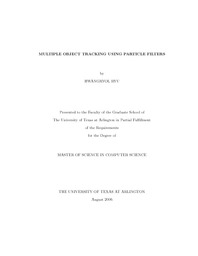
ATTENTION: The works hosted here are being migrated to a new repository that will consolidate resources, improve discoverability, and better show UTA's research impact on the global community. We will update authors as the migration progresses. Please see MavMatrix for more information.
Show simple item record
| dc.contributor.author | Ryu, Hwangryol | en_US |
| dc.date.accessioned | 2007-08-23T01:56:13Z | |
| dc.date.available | 2007-08-23T01:56:13Z | |
| dc.date.issued | 2007-08-23T01:56:13Z | |
| dc.date.submitted | May 2006 | en_US |
| dc.identifier.other | DISS-1325 | en_US |
| dc.identifier.uri | http://hdl.handle.net/10106/180 | |
| dc.description.abstract | We describe a novel extension to the Particle filter algorithm for tracking multiple objects. The recently proposed algorithms and the variants for multiple object tacking algorithms estimate multi-modal posterior distributions that potentially represent the multiple peaks (i.e., multiple tracked objects). However, the speci¯c state representation does not demonstrate birth, death and more importantly partial/complete occlusion of the objects. Furthermore, the weakness of the Particle Filter such that the representation may increasingly bias the posterior density estimates toward objects with dominant likelihood makes the multiple object tracking algorithms more di±cult. To circumvent a sample depletion problem and maintain the computational complexity as good as the joint Particle fillters under certain assumptions: (1) targets move independently, (2) targets are not transparent, (3) each pixel of image only come from one of the targets, we proposed a new approach dealing with partial and complete occlusions of a fixed number of objects in an e±cient manner that provides a robust means of tracking each object by projecting particles into the image space and back to a particle space. The projection procedure between the particle space and the image space represents an important probability density function not only to give more trust to a target being visible, but also to explain an occluded target. In addition, the joint Particle filter from the curse of dimensionality in the number of the targets to being tracked, whereas the proposed algorithm only adds a constant factor to the computational cost of the standard Particle filters. To present qualitative results, the experiments were performed over the sequence of the real images which is composed of the rectangular boxes in the different colors. The experiments demonstrated that the Particle filters implemented using the proposed method effectively and precisely track multiple targets, whereas the standard Particle filters failed to track the multiple targets. | en_US |
| dc.description.sponsorship | Huber, Manfred | en_US |
| dc.language.iso | KO | en_US |
| dc.publisher | Computer Science & Engineering | en_US |
| dc.title | Multiple Object Tracking Using Particle Filters | en_US |
| dc.type | M.S. | en_US |
| dc.contributor.committeeChair | Huber, Manfred | en_US |
| dc.degree.department | Computer Science & Engineering | en_US |
| dc.degree.discipline | Computer Science & Engineering | en_US |
| dc.degree.grantor | University of Texas at Arlington | en_US |
| dc.degree.level | masters | en_US |
| dc.degree.name | M.S. | en_US |
| dc.identifier.externalLink | https://www.uta.edu/ra/real/editprofile.php?onlyview=1&pid=190 | |
| dc.identifier.externalLinkDescription | Link to Research Profiles | |
Files in this item
- Name:
- umi-uta-1325.pdf
- Size:
- 1.203Mb
- Format:
- PDF
This item appears in the following Collection(s)
Show simple item record


